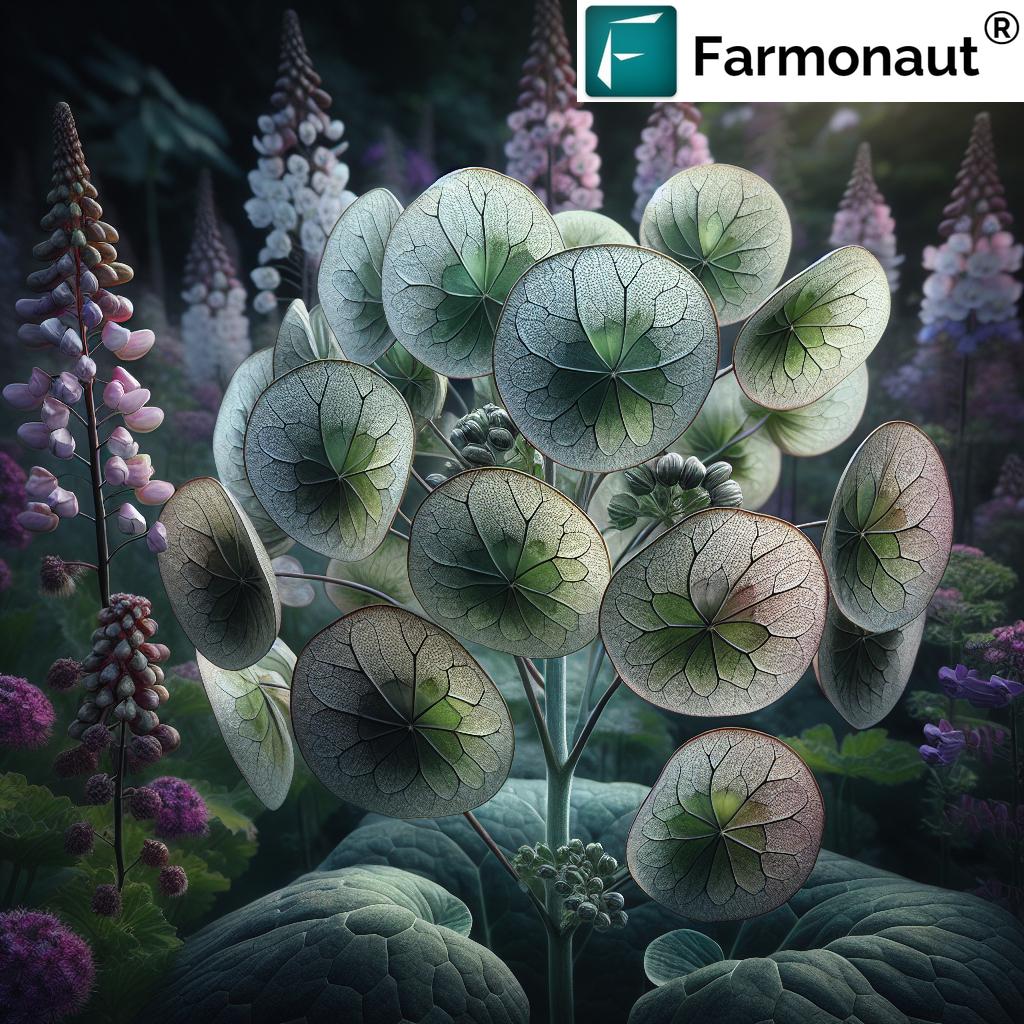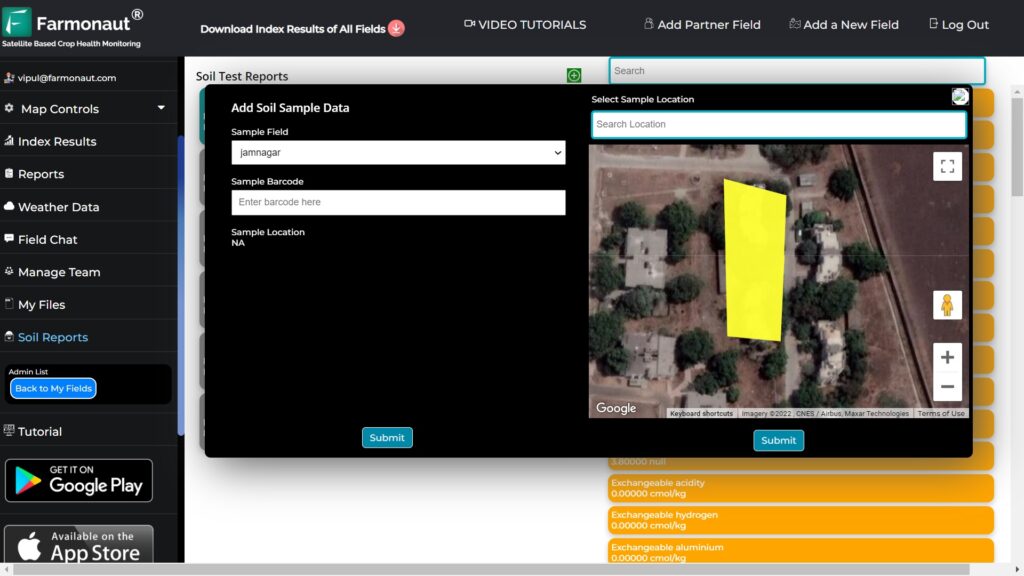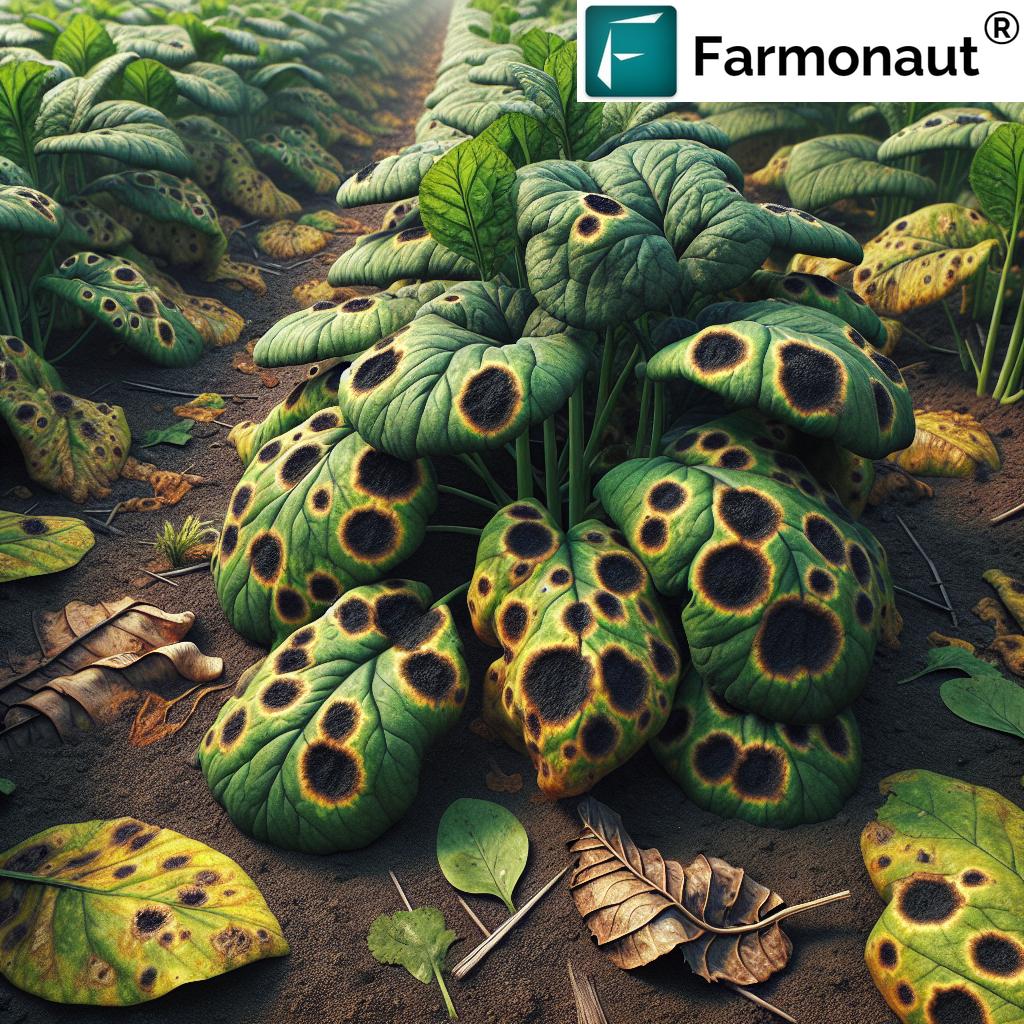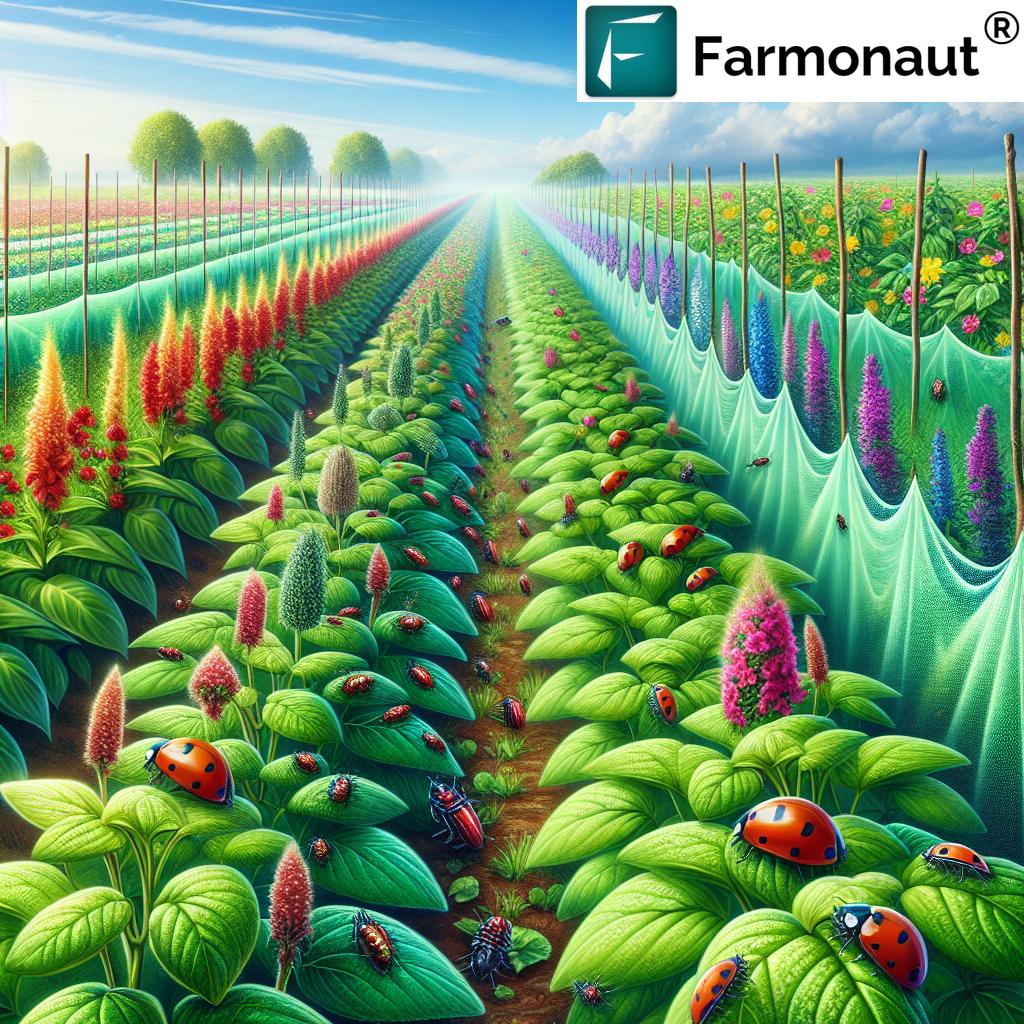Lunaria Plant: 7 Powerful Tips for Spectacular Seed Pods
“Lunaria seed pods are just 2-3 cm wide, yet their translucent beauty inspires innovative space agriculture research.”
Table of Contents
- Introduction: The Allure of Lunaria Plant
- Botanical Characteristics of Lunaria Annua
- Distribution, Habitat, and Cultural Significance
- Lunaria Plant Growth & Utility Comparison Table
- 7 Powerful Tips for Spectacular Honesty Plant Seed Pods
- Propagation: Sowing Seeds, Division, and Cuttings
- Uses in Agriculture, Horticulture, and Herbal Traditions
- Lunaria’s Role in Innovative Space Agriculture Projects
- Farmonaut: Precision Agriculture Technology for the Future
- Frequently Asked Questions About Lunaria Plant
- Conclusion: The Future of Honesty Plant in Gardens and Beyond
Introduction: The Allure of Lunaria Plant
The lunaria plant, with its alluring translucent seed pods that resemble silvery coins, has beguiled gardeners, botanists, and dreamers for generations. Belonging to the Brassicaceae family, the genus Lunaria is native to the lush woodlands of Europe and parts of Asia. Often celebrated as the honesty plant or money plant, it stands out among biennial flowering plants for its ornamental seed structures and dynamic role in classic and modern space agriculture research.
Whether you’re seeking a striking addition to wildflower gardens for temperate climates, stunning dried floral arrangements, or simply want to master growing lunaria annua, this comprehensive guide will unwrap everything you need to know about cultivating honesty plant in gardens—and reveal why its future is being shaped by technological innovation.
Botanical Characteristics of Lunaria Annua
Lunaria annua—the best-known species of the lunaria genus—thrives as an annual or biennial plant and is frequently admired for its distinctive form. Understanding its unique growth habits and appearance helps ensure a successful cultivation process.
Key Features of Lunaria Plants
- Height: Typically grows up to 90 cm (about 35 inches), making it a notable presence among ornamental plants for floral arrangements.
- Leaves: Broadly oval, coarse, and serrated-edged.
- Flowers: Displays white, pink, or classic violet flowers in spring.
- Seed Pods: Produces round, flat, translucent seed pods known as “siliques” that, when mature, resemble silver coins (moonpennies).
- Root System: Tends to feature a well-developed taproot, contributing to its adaptability and resilience.
Throughout late spring and early summer,lunaria plants dazzle pollinators with clusters of fragrant blooms—a prelude to the main attraction: rapidly developing green pods that mature to expose their iconic silvery membranes.
In the context of floral arrangements and interior décor, these honesty plant seed pods are invaluable, prized for their longevity and elegant visual appeal long after the plant’s flowering phase has ended.
“NASA studies Lunaria for its potential to thrive in microgravity, advancing future floral cultivation beyond Earth.”
Distribution, Habitat, and Cultural Significance
Originating in the lush forests of southern Europe, Lunaria annua now grows wild across much of temperate Asia and has been introduced worldwide. Its preference for well-drained, nutrient-rich soils and ability to thrive in partial shade or full sun—depending on local climate—makes it remarkably adaptable to various garden settings.
Where Lunaria Thrives
- Native Habitat: Woodland clearings, hedgerows, and the edges of shaded glades in southern and central Europe.
- Introduced Regions: North America (including parts of the United States), Australia, temperate zones in Asia, and gardens worldwide.
- Preferred Conditions: Lunaria plants grow best in rich, well-drained soils; they prefer full sun in cooler climates, but benefit from afternoon shade in warmer areas.
- Hardiness Zones: USDA zones 5 through 9, making honesty plant suitable for a wide range of temperate environments and wildflower gardens.
Because lunaria plant adapts so well, it often naturalizes in new areas—sometimes so vigorously that it is classed as an invasive species in several temperate regions worldwide.
Lunaria Plant Growth & Utility Comparison Table
| Feature | Lunaria Plant (Estimated Values) | Typical Flowering Plant |
|---|---|---|
| Germination Time (days) | 14–21 days | 7–14 days |
| Height at Maturity (cm) | 60–90 cm | 30–75 cm |
| Seed Pod Transparency (%) | ~90% (distinctively translucent) | <10% (opaque, if present) |
| Soil Type Preference | Rich, well-drained loam | Varies by species; often loamy or sandy |
| Watering Frequency | Moderate; do not let soil dry out | Low to moderate (species dependent) |
| Use in Traditional Gardens | Popular for wildflower and shade gardens, decorative dried pods | Common for beds, borders, and color accents |
| Use in Space Agriculture Projects | Yes: Subject of lunar horticulture research due to resilience and unique pod structure. | Rare (few annuals/biennials studied for microgravity adaptation) |
Access satellite-powered agricultural insights and advisory from anywhere with the Farmonaut app—available for web, Android, iOS devices.
7 Powerful Tips for Spectacular Honesty Plant Seed Pods
The key to growing lunaria annua with remarkable translucent seed pods that resemble coins lies in attentive cultivation and smart placement. Here are the most effective tips for boosting both plant health and the quality of your garden’s moonpennies:
1. Choose the Right Location
- Lunaria plants prefer dappled sunlight or partial shade, especially in warm climates. In USDA zones 5–9 and temperate regions of Europe and Asia, situate these biennial flowering plants in areas that receive morning sun and afternoon shade for optimal development.
2. Prepare Nutrient-Rich, Well-Drained Soil
- The honesty plant flourishes in soil amended with organic matter (like compost or well-rotted manure). Ensure soil remains moist but never waterlogged. Sandy-loam or loam soils with good drainage mimic its native habitat best.
3. Soak and Sow Seeds at the Right Time
- Propagating lunaria from seed works best if seeds are soaked in water for about 24 hours before sowing. Sow directly outdoors in late spring or early summer, or start indoors 6–8 weeks before the last frost. Germination typically takes 2-3 weeks at 65-70°F (18–21°C).
4. Maintain Even Moisture During Establishment
- Water thoroughly but allow the soil’s top layer to dry to the touch between waterings.Consistent moisture encourages sturdy seedling development and prevents premature flowering.
5. Thin and Space Seedlings Properly
- To avoid overcrowding, thin seedlings to 20–30 cm (8–12 inches) apart. Generous spacing supports larger, more robust plants and increases the production of spectacular seed pods.
6. Remove Flowered Stalks Cautiously
- After lunaria flowers in spring, avoid cutting entire stalks; instead, wait until seed pods develop fully and dry naturally before harvest. This preserves the iconic translucent siliques used in floral arrangements.
7. Allow Natural Reseeding for Perennial Beauty
- Lunaria is known to naturalize easily—let some pods shatter and drop their seeds for recurring displays. In wildflower gardens for temperate climates, a single patch can evolve into a flourishing honesty plant colony year after year.
For developers and agribusinesses seeking integration with advanced farm monitoring, our robust Farmonaut Satellite API and dedicated API developer docs provide seamless access to crop health, weather data, and more.
Propagation: Sowing Seeds, Division, and Cuttings
How do you multiply and maintain Lunaria in your garden year after year?
There are three trusted ways to propagate and keep your honesty plant flourishing:
Sowing Seeds
- For propagating lunaria from seed, collect pods after they’ve dried on the stalk. Crumble the seed pods gently between your hands—the flat brown seeds inside are what you’ll sow for the next year.
- Soak seeds in water overnight, then plant them about 0.5–1 cm (¼–½ inch) deep in moist, well-prepared soil.
- Keep the area moist and expect sprouting within 2–3 weeks, especially if soil temperatures stay between 65–70°F (18–21°C).
Division of Established Plants
- Early spring or autumn are the best times for division. Carefully dig up a mature lunaria cluster, separate sections with several roots and shoots, then replant immediately. Water thoroughly but avoid standing water.
Rooting Cuttings
- Take non-flowering stem cuttings about 8–10 cm (3–4 inches) long. Strip lower leaves and set in a mixture of peat and perlite; maintain high humidity while roots form (usually 2–3 weeks).
Pro Tips for Success with Translucent Seed Pods
- Grow lunaria in established shady beds near trees or on the north side of buildings for optimal pod display.
- Mulch the base with leaf mold to mimic the plant’s woodland origins and conserve moisture.
Uses in Agriculture, Horticulture, and Herbal Traditions
While the primary value of lunaria annua is ornamental, its significance traverses gardening, agriculture, and folklore:
- Floral Arrangements:
The distinctive, silvery pods retain their shimmer long after harvest. Artists and florists worldwide use honesty plant seed pods in bouquets, wreaths, and table centerpieces for a touch of ethereal beauty. - Wildlife Gardens:
Lunaria flowers in spring attract long-tongued bees, butterflies, and a variety of pollinators, promoting biodiversity in temperate gardens. - Traditional Herbal Medicine:
Young roots are edible, used—raw or cooked—in some regional herbal traditions. - Ecological Impact:
The plant’s easy ability to naturalize makes it both a boon and a potential risk: in favorable areas, honesty plant can become an invasive species competing with local flora. - Cultural Meaning:
In the Victorian language of flowers, lunaria stands for “honesty,” “sincerity,” and “wealth”—meanings reinforced by the pods’ resemblance to coins.
In occult and folk traditions, honesty is believed to repel evil spirits and ensure prosperity, even making appearances in ancient flying ointment recipes tied to the moon.
Interested in ensuring product traceability and supply chain transparency for your agricultural products? Farmonaut’s blockchain-based traceability platform offers secure, tamper-proof tracking from farm to table—vital for increasing consumer trust in food and floral products.
Working towards making your cultivation more sustainable? Farmonaut’s carbon footprinting solution allows growers and agribusinesses to monitor, analyze, and minimize their environmental impact, with real-time emissions tracking and compliance insights.
Lunaria’s Role in Innovative Space Agriculture Projects
Lunaria, with its resilience and adaptability, has captured the imagination of agricultural innovators. Its unique growth patterns and ornamental appeal are now inspiring experiments in one of humanity’s last frontiers–space.
Lunaria One: Growing Plants on the Moon
- Lunaria One, an Australia-based initiative, has selected the honesty plant for a pathfinding mission on the lunar surface. This research aims to gauge lunaria’s ability to germinate, survive, and thrive under lunar microgravity, leveraging the plant’s strong adaptation to diverse terrestrial conditions.
- Scheduled for deployment in the 2025 mission to the Moon, this project could reveal critical insights into space-based agriculture—paving the way for future floral cultivation on extraterrestrial colonies and Mars.
- The mission will monitor seedling growth, flowering, pod development, and resilience in the harsh lunar environment, making the honesty plant an ambassador for terrestrial horticulture beyond Earth.
Why is Honesty Plant Ideal for Space Experiments?
- Bearing Spectacular Seed Pods: Quick maturity and high visibility of growth milestones.
- Biennial Flowering Plants Adaptability: Its life cycle fits well for time-bound space experiments.
- Symbolic Resilience: The plant’s endurance in both shade and sun, moist and moderately dry soils, mimics the varying conditions expected in controlled lunar or Martian biospheres.
Large agribusinesses and commercial growers can benefit from Farmonaut’s advanced fleet management and resource optimization tools. These systems enable efficient monitoring, tracking, and deployment of agricultural vehicles and equipment, cutting operational costs and improving productivity even for specialty crops like the lunaria plant.
If you’re seeking enhanced access to financing, explore Farmonaut’s satellite-based crop loan and insurance verification platform, designed to reduce fraud and speed up loan/insurance approvals for farmers and agricultural businesses.
Farmonaut: Precision Agriculture Technology for the Future
Modern agriculture is evolving rapidly. Integrating technology—just as Lunaria is now integrated into innovative agriculture projects—empowers farmers, agribusinesses, and researchers alike.
At Farmonaut, we leverage advanced technologies such as satellite-based crop health monitoring, AI-driven advisory systems, blockchain traceability, and carbon footprinting to bring efficiency, sustainability, and transparency to modern farming. These tools aren’t just for high-yield cereals—they’re invaluable for niche and ornamental crops, including honesty plant.
Farmonaut Platform: Key Features for All Growers
- Satellite Crop Monitoring: Multispectral analytics for NDVI, soil moisture, and stress detection, enabling timely intervention in gardens, wildflower patches, and ornamental plantings.
- Jeevn AI Advisory: Personalized crop advisory combining weather forecasts, best-practices, and real-time remote sensing—perfect for tracking unpredictable flower/bud cycles in biennial flowering plants.
- Blockchain Traceability: Promote consumer trust for premium and specialty crops such as lunaria seed pods.
- Fleet & Resource Management: Optimize every step of your horticultural or agricultural operation, reducing costs and environmental impact.
- Carbon Tracking: Understand, track, and improve your environmental footprint—contributing to truly sustainable agricultural futures.
Our platform empowers not only field crop managers, but also specialty growers and landscapers looking to integrate innovative space agriculture principles right here on Earth.
Are you managing wildflower gardens, ornamental plant plantations, or seeking comprehensive field insights? Discover Farmonaut’s large-scale farm management suite—ideal for plant nursery supervisors, horticulture directors, and research teams.
Frequently Asked Questions About Lunaria Plant
What is the best time to sow lunaria seeds?
Sow lunaria seeds directly into the ground in late spring or early summer, after the last expected frost. Indoor sowing can begin 6–8 weeks prior to the last frost for a head start.
Why are lunaria seed pods so popular in floral arrangements?
The unique disc-shaped pods are nearly translucent, featuring a silvery, coin-like membrane that beautifully catches and diffuses light—an effect not found in most ornamental plants.
Is lunaria plant invasive?
Lunaria annua can become invasive in certain regions, such as parts of the United States and Australia. Monitor for unwanted spread and manage accordingly.
How can I use lunaria in wildflower gardens?
Mix honesty plant seeds with those of compatible temperate wildflowers. Their biennial habit ensures reliable spring color and pod display year after year.
Can lunaria grow in shade?
Yes, lunaria tolerates and often prefers partial or dappled shade, especially in locations with hot summers.
What uses does the honesty plant have beyond gardening?
In addition to dried flower design, honesty plant roots were historically used in herbal medicine, and lunaria continues to hold cultural and folkloric symbolism for truth and prosperity.
Conclusion: The Future of Honesty Plant in Gardens and Beyond
From southern Europe’s woodlands to backyard borders around the world—and now, to the far reaches of lunar exploration—lunaria plant stands as a dazzling icon of resilience, elegance, and innovation. Its translucent seed pods that resemble silver coins delight traditional gardeners, designers, and agricultural scientists alike.
While its enduring popularity in floral arrangements, wildflower gardens for temperate climates, and shade-friendly plantings is undisputed, the honesty plant now inspires discovery at the very frontier of agricultural science. As research continues in both terrestrial and space-based agriculture, cultivating honesty plant in gardens symbolizes a fusion of history and the future of floral cultivation.
Ready to elevate your approach to crop cultivation, sustainability, or farm management? Explore Farmonaut’s transformative platform—where the worlds of tradition, technology, and innovation unite.


















